Italy/France 2007.
Italy (Torino)/France (Paris/Grenoble) 2007
Since we’ve been to Paris often we research new places to visit and eat mostly through the Internet. For this trip we got many ideas (for Paris and also for Italy) from the American Foodie in Paris website. http://www.davidlebovitz.com/
We used the Time Out Paris guide as our main source of information. The Time Out city guides are quite comprehensive and generally have good maps (this one has a good map reference guide for looking up specific locations). You’ll note that when we give an address in Paris the street # is sometimes followed by another number, which indicates which arrondissement (neighborhood, like a zip code) it is in – this is a common way of stating Paris addresses.
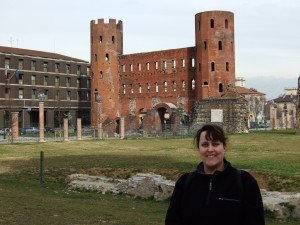
Did my grandparents walk these same streets? I’ll never know, but Piedmont/Piemonte is a terrific region to explore, free of mass tourism and full of sites to see and food to eat. Read more about Turin in my Suite101 website article about the Eataly, the city, and its food.
We purchased the Lonely Planet Piedmont guide for our trip to Italy, but it didn’t provide all that much more coverage than what was already covered in the LP Italy. We were pleased, however, with its coverage of gelaterie in Torino. You’re better off just buying the entire Lonely Planet Italy book and tearing out the relevant pages and also getting a good map of the city of Torino upon arrival at the train station (the free one at the Tourist Information Center is adequate, but if you are renting a car and traveling around Piedmont you will want to purchase a more detailed road map).
Torino (Turin) played a pivotal role in the Risorgimento (the unification of Italy), houses one of the most important Egyptian collections in the world, and the region of Piedmont is the birthplace of the Slow Food Movement and has a rich gastronomic history, yet the city and the province are overlooked as a tourist destination. Piedmont is Italy’s second largest province, but it earns just 3.3% of the country’s total tourist dollars.
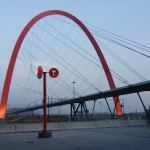
The Olympic Bridge
Although the 2006 Olympics were held here and brought the city into the international limelight for a few weeks, this glory was temporary and it remains unvisited by most travelers to Italy. All of this means that Torino is an authentic Italian city, not a tourist trap or fantasy land, and outside the city there is very little tourism aside from some ski areas. Unlike so many other destinations in Italy, most of the people you encounter on the streets live here (though it’s very likely that they are not originally from here since there is massive migration to here from around Italy, the newer members of the EU, Albania, and northern Africa). Torino also has a history of mass emigration — despite the fact that the majority of Italian-Americans have their roots in southern Italy, Piedmont was actually one of the leading contributors to early waves of emigration in the mid-late 1800s.
Among those early emigrants were Annabella’s great grandparents, who settled in an agricultural region of Argentina that saw more immigrants from Piemonte than from any other province, a fact that has influenced its cuisine, character, and ethnic makeup to this day (stop any native on the streets of Torino and we can almost promise you they have family that emigrated to Provincia de Santa Fe, Argentina, though many of these early emigrants did eventually return to Italy).
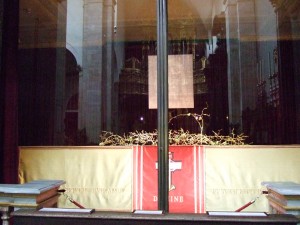
Torino’s most famous site/object is the Shroud of Turin (Santa Sindone). The Shroud itself is only displayed for special holy years, but it will be exhibited again ahead of schedule in Spring 2010. In the meantime, you can see its museum, replica, and special exhibits.
We had originally planned to rent a car for a couple of days and drive outside the city, but it there was so much to see and do that we decided to just stay in Torino and save the Piedmont travel for another trip.
23 February 2007
Upon landing in Paris we attempted our first use of our new Mobal International cell phone. We paid $50 for the phone, which has no monthly or annual fees and you just pay for the minutes you use. The minutes are expensive, but since this phone works in most countries without a need for any additional software or hardware, it’s a good alternative for someone needed just emergency and/or occasional access. Since we were meeting a friend who works at CDG Airport we needed to use it right away but had some trouble with the code sequence. It’s important to keep all the paperwork with you for an item like this. We got it to work and met our friend for breakfast, crazy pricey at €20 for a cappuccino, tea, and orange juice.
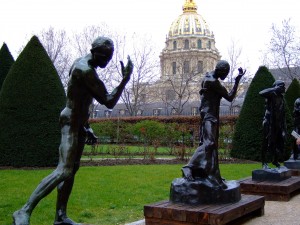
On the grounds of the Rodin Museum.
We usually take the RER train into Paris, but since we had cashed in Starwood points for a free night at Le Meridien Montparnasse, we took the AirFrance Bus to Gare Montparnasse. The planned time was 30 minutes, but after going around in circles at CDG picking up passengers it was much more than an hour. At €12 per person it was also more expensive than the RER (€8), but easier for someone staying at a hotel a short walking distance from one of the stops. We would certainly never take it again unless staying adjacent to one of the stops.
It had been years since we’d had a Croque Monsieur, so we researched the best one in Paris and headed to Le Nemrod at 51 rue Cherche Midi (6e). We upgraded from the €6 to €8 for the famed pain Poilaine. We also had a steak and potatoes and wine. The croque was really a disappointment, just a $15 grilled ham and cheese sandwich.
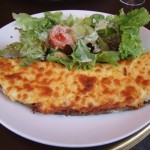
Croque Monsieur on Pain Poilane
We silently chuckled as the Americans a few tables over didn’t order the pain Poilane and were disappointed when theirs came out on plain bread. Waiters in France are difficult under the most ideal of circumstances and are certainly not understanding of a goofed up order caused by your own stupidity. We were tempted to tell them it was no great loss, but we’ve learned it’s better to just shut up in these situations. The waiter refused the exchange anyway.
From Nemrod we walked around until with got to the Chapel of the Miraculous Medal (La Chapelle Notre Dame de la Médaille Miraculeuse) at 140 rue de Bac (7e), which had been featured in our Weird Europe guidebook because it contains the uncorrupted body of St. Catherine Laboure, on display in a glass case in the chapel. We were surprised by the large number of pilgrims, most of them foreign, visiting a site that we had not been very familiar with before. Next door we visited a museum regarding French missionaries. This site contains good information about this and other religious sites: http://www.sacred-destinations.com/france/paris-chapel-of-miraculous-medal.htm
Afterwards we crossed the river to the Petit Palais, which houses many art nouveau sculptures, Renaissance paintings, and temporary exhibits. The lines were far too long at the Grand Palais and the Orangerie to bother going in. Dinner was not memorable, and we turned in early.
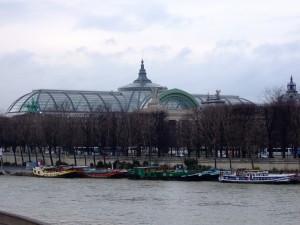
24 February
The Musee Bordello was a short walk from our hotel, and while normally free had a special exhibition that was not and did not interest us, so we moved along to the Rodin Museum. On a prior trip to Paris we’d had a fight the day we went to the Rodin, but this time we were able to enjoy it. With her teacher ID Annabella got in for free, and she had hoped to get a lesson for her middle school French class out of the visit though decided against planning one around the special erotica exhibit.
Rodin left many sculptures unfinished, so it is interesting to see works in progress along with explanations of the sculpture-making process.
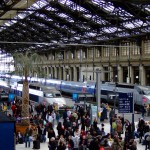
Crowds awaiting the TGVs heading south for ski trips in the Alps.
Then we headed to the train station to catch the TGV to Grenoble. Disney was promoting new DVDs at the station, which gave us some goofy photo ops and a distraction while awaiting the train. Having the skill of speaking French, my wife discovered that booking tickets on the French side of the train site allows you far more options and better deals which the English version of the site does not contain at all. By using the French side of the site we were given an option for taking a train at a different hour that also allowed us a free upgrade to 1st class. http://www.voyages-sncf.com/
As usual we proudly made our dinner sandwiches with “banned in the U.S.” cured ham and smell soft sheep’s milk cheese made from raw milk, both of which made us lament FDA regulations that require food to be sterilized and preserved to the point where it kills not just the bacteria but also the taste. How do more than 700 million Europeans manage to stay alive??

TGV quiet cars — cell phones asleep, s’il vous plait.
Mandy, Annabella’s friend she hadn’t seen in almost 20 years, picked us up at the station in what she calls her “European clown car.” She blogs about expat life here since her husband was transferred to Grenoble at this site: http://www.kaitlyn-marsue.net/
Apparently a popular item in the Grenoble suburbs is the Pizza Truck, a mobile pizza restaurant. We ordered 3 pizzas, including one topped with mini ravioli. Grenoble has many Italian restaurants and Italian-influenced foods due to its proximity to Italy and some immigration. The pizzas were good, and convenient.
25-28 February
We spent time visiting with our friends and seeing the sites around Grenoble.
Fulfilling our love of factory tours, we went to the Chartreuse Distillery, still run by the Carthusian monks. They offer a guided tour of the caves and a tasting. The highlight of the tour is surely the 3D movie, one of those ones where they tried very hard to find scenes that would excite the audience to see filmed in 3D (like a thrilling scene of a monk chopping wood for the oak barrels where the axe comes flying out towards you).
We liked the Chartreuse-filled chocolate.
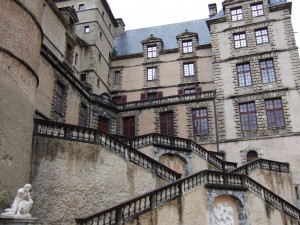
French Revolution Museum
Mandy took us to a museum of the French Revolution where we learned next to nothing. But we did learn a lesson at lunch: “When the waiter comes to tell you something and the French speaker leaves the table, you should ask the waiter to come back later.” Annabella had gone to the restroom when the waiter must have said something like, “We’re all out of mozzarella, would you still like to have an enormous platter consisting of nothing more than sliced tomatoes, but we’ll still charge you full price for the appetizer?”
In downtown Grenoble we visited a miniature fun fair – basically just a food stand and a giant slide. We watched a kid get a giant cotton candy (Barbe a Papa, “father’s beard,” in French) that I didn’t imagine would end well, and you can see what transpired from the photos.
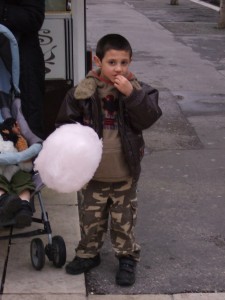
Happy one minute.
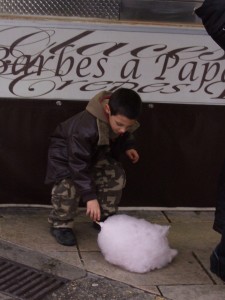
Sad the next.
1 March
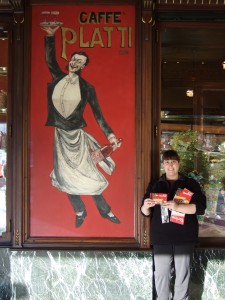
Holding the Torino Card and Choco Pass (and Choco Map) in front of one of the stops.
Train to Italy and arrival in Torino and first stop at the helpful TIC (Tourist Information Center) in the main railway station. We purchased a multiday Torino+Piemonte Pass which allows you unlimited entrance to virtually every museum in the area as well as unlimited public transportation. Only €22 (2009 price) for 3 days and a real bargain. For an additional €12 we obtained a Chocopass, allowing us 22 tastings over the course of 3 days at different chocolatiers around the city. With the Chocopass comes a terrific list of places and a map so you can eat your way across the city (some places allow you to taste hot chocolate or cake but most give you some pieces of chocolate…) You can find a wealth of information about the city and region (and its chocolage) at this website: http://www.turismotorino.org
A great thing about the Torino Card, like other museum passes around the world, is that you are free to go in and out of museums at your leisure (even if only to use a restroom). We visited the Museum of Decorative Arts, which was donated to the city by an art gallery dealer with no children. No photos allowed. Lots of furniture, copper kitchen items, little enamel boxes, porcelain, crystal, etc. We had lunch right down the street on Via Po at a tavola calda buffet for just €7 including water and coffee. We stuffed ourselves with cheese, prosciutto, different pastas, veggies, and desserts, all good quality.
The Museo Nazionale del Cinema in the base of the Mole Antonelliana (the odd-looking tower that watchers of the 2006 Winter Olympics will recognize) is a real gem. For a while we laid down on the red lounge chairs and watched slides on the ceiling, like Lanterna Magika, and then watched movie clips on the giant screens. The sound comes in from speakers in the chair at a deafening level (Italians do like it loud, like at my parents’ house).
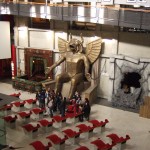
Relax and watch film clips at the Cinema Museum.
Props, posters, displays, and movie clips are all over the museum generally organized by genre. A film buff could spend all day here. Our favorite was the Red Room with old, naughty stereoscope photos.
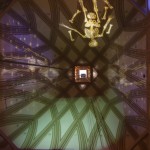
Projecting Lanterna Magika on the ceiling of the Mole, part of the Cinema Museum.
Unseasonably warm weather made it pleasant to walk to the historic Al Bicerin café (since 1763) for a Bicerin (coffee, chocolate and cream drink) and for a slice of chocolate cake with our ChocoPass voucher. The place is tiny, but there is a steady stream of people coming and going very quickly. You know how in the U.S. “George Washington Slept Here?” Well, unfortunately Garibaldi never ate here, but Puccini, Nietzsche, Alexander Dumas, Italo Calvino, and now Vito and Annabella have had a drink here.
We thought we would be so smart taking a train to the hotel in Lingotto for a quick 6 minute ride instead of the long bus ride. It was quick alright, but the sottopassaggio/underpass that crosses over to the hotel area is permanently closed (not on the map, though!). So we ended up walking more than a mile through the Olympic Village and across the bridge. In typical Italian fashion things were ridiculously disorganized and maddening. Good thing we travel light – something we never regret. Le Meridien Lingotto is a great hotel with the largest hotel rooms and highest ceilings I think we’ve ever seen in Europe and also a large and comfy bathroom. Since it’s primarily a business hotel you can get great rates on the weekends, when the hotel is super quiet and the staff very friendly.
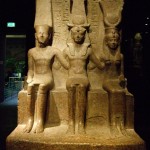
Museo Egizio — One of the world’s top collections of Egyptian antiquities, spendidly displayed with a lighting scheme that highlights the mysteries of Ancient Egypt.
The hotel is in the old Fiat Factory. As a guest they give you a key to go up the roof, now a jogging track but once the Fiat test track. From the roof deck there was an entrance to the Pinacoeca Agnelli, the Agnelli art collection. It’s small, with only about 50 paintings, including several Canalettos and Modigliani.
A few weeks before our trip the gourmet superstore Eataly opened up, right across the street from the hotel. It’s like an Ikea for food. The building was once a vermouth factory, and upstairs is the factory museum. You can visit their cheese and prosciutto storage rooms and smell the food as you approach. They have a series of little restaurants, “ristorantini,” each serving a particular type of food. We had a snack of a glass of Dolcetto wine and a cheese plate in the cheese area.
2 March
Sat next to a chatty old woman on the bus whose family had emigrated to the same part of Argentina where Annabella’s father is from, just like her grandparents from Piemonte had. She was complaining about how disorganized Italy is and how they change the bus routes and other things without any warning (their conversation started by her asking if she was on the correct bus).
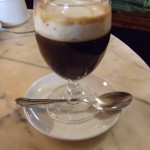
The namesake drink at the historic Il Bicerin.
It was our lucky mistake that the bus took a slightly different route than anticipated because we ended up near the Museo Pietro Micca that we thought we would end up missing. We got there just in time to join a school group on their tour of the underground tunnels where the Piedmontese patriot Pietro Micca fought off the French. 2006 was the 300th anniversary of the Siege of Torino, and the 1706/2006 exhibits were still ongoing. Our tour guide Luciano was excellent.
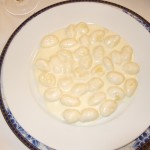
Gnocchi with Castelmagno cheese — a classic Piedmontese dish with a local cheese that is very delicious but difficult to find in the U.S.
I egged on the kids asking them if Dracula was around the corner, and the girls all clutched each other. Then I pulled out the word “pippistrella” (bat), and the class clown (every classroom around the world has one) kept teasing the girls about a fluttering bat. The tour is well done and has some film projections that are done at the end of a tunnel and look very lifelike, as if the men are actually standing there. They speak in the very Francophone Piedmontese dialect. Luciano asked the kids of they understand Piemontese, and they all shouted “Si!!!!!!!” I asked Class Clown whether they learned it at school, and he said, “No, we just know it.” My wife talked to the teacher who said they also have increasing discipline problems in the public schools, issues with the parents, language troubles with immigrants (her class had kids from Romania, Moldova, Morocco).
Pietro Mica was a miner who blew up lots of French people before losing his own life during the siege. The kids were particularly disturbed that when they burned the bodies of more than 2,000 fighters during an August battle that many of the wounded, including Piemontesi, were burned alive.
Nearby is the Citadel that the tunnels led to. We had to rush through the 1706 exhibit so that we’d still have time to make the Turismo Torino Bus, a hop on/hop off bus that is free with the Torino Card. We got off the tour near the Cioccolato Festival. It was the first day and the weather was good. First we ate a delicious lunch of steak with arugula and a pasta Monte e Mare (mountain and sea) that was a combo of mushrooms and shrimp that was so outstanding that we ordered another plate, a good value at €5.60.
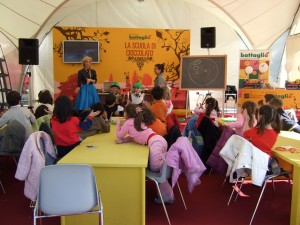
School Group at the Chocolate Festival “Scuola di Cioccolato” learning valuable lessons on an important topic.
Cioccolato was actually a bit disappointing since there was a true lack of artisanal, small chocolatiers. It was mostly large manufacturers such as Lindt, Droste, and Caffarel. We did enjoy some varieties of hot chocolate but were disappointed by the hot pepper variety sold to us by a real character wearing leather pants and an Austrian yodeler type of hat. There was an area for children with hands-on and educational activities, but not must for adults during the day.
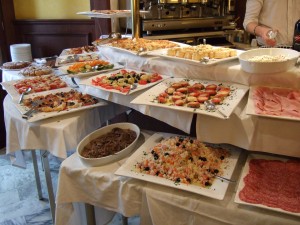
Tavola Calda — a delicious lunchtime bargain buffet.
We headed back to revisit the Palazzo Madama and see jewelry exhibit, but on the crowded bus we realized that someone had unzipped Annabella’s bag, which contained no real valuables (since we keep money and cards in our neck and waist pouches), but she couldn’t remember if the cell phone was in her purse or not, so we had to rush back to the hotel. Lesson learned – put a lock code on the phone so that a thief can’t run up your bill!
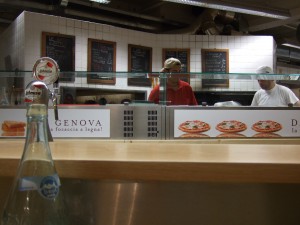
One of the Ristorantini in Eataly – this one dedicated to Pizza.
After figuring out that the cell phone was tucked away in the hotel safe, we went to the adjoining mall to buy movie tickets, but everything is dubbed into Italian (which wouldn’t bother us all that much if it wasn’t that the original language is English). So we left to go back to Eataly and have another cheese plate. We walked around the neighborhood and ate more chocolate.
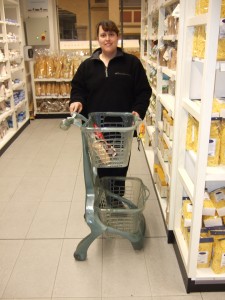
Shopping cart in Eataly.
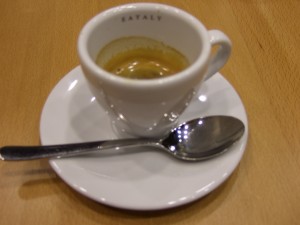
The “large” coffee at Eataly.
3 March
Final day in Italy started with a leisurely buffet breakfast at the hotel, which was excellent. We hopped over to Pam supermarket to buy a few things to take home, like Pocket Coffee, which is essentially chocolate-covered coffee (be careful not to spill when you take a bite!).
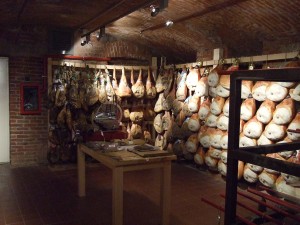
Prosciutto storage.
We walked to the Museo Nazionale dell’Automobile, less than a 10 minute walk from the hotel (please note that in Fall 2009 the museum closed for renovation. There is a temporary exposition at Torino Esposizioni – Padiglione Agnelli, corso Massimo d’Azeglio 15 (check the website for reopening dates). My wife sat on a bench reading a book while I walked around.
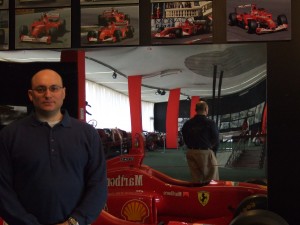
Disneyland for Vito = Auto Museum.
A man was explaining things to his children, Dario and Anna, and saying things like, “Here are the kind of cars people had even before Nonno Vittorio and Nonno Emilio were born.” They came up to my wife and the kids asked, “Who is she?” She answered, “Qui c’e una donna che non piace le auto ma chi va al museo per fare piacere al suo marito.” (Here is a woman who doesn’t like cars but goes to the museum to make her husband happy). There was an exhibit of a Ferrari that toured China and many Italian cars from across time.
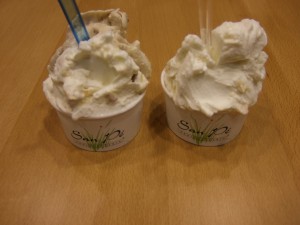
Gelateria in Eataly — among the finest gelato in the world, fresh made with milk from Piedmontese cows and only whole food ingredients. To taste the true quality of gelato always try the vanilla flavor in order to really savor the richness.
Back to Eataly for lunch, where we chatted for a while with Luigi at the chocolate counter who said he dreams of going to USA and hope they’ll build an Eataly there (now slated to open near Madison Square Garden in Spring 2010). We had pizza that was a little watery and not so great and we were sorry we hadn’t gotten pasta, which
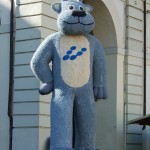
Olympic Mascot — We believe this is “Gliz,” the ice cube.
looked great. Annabella talked to a man at the gelato counter whose grandparents had also emigrated to the same region in Argentina as her grandparents. The man’s son was very sweet and excited for his gelato and was counting out lots of small change he’d saved up and was very proud of it!
In downtown Torino a bit more confusion about purchasing the SADEM bus tickets to go to the airport. They must be purchased from a local bar, and there’s a 25% discount with the Torino Card. Italian-style, the 2:15 bus was late though the 3:00 bus was just idling there. We made it in plenty of time and arrived back to Paris on time.
We took the RER to our usual Paris hotel, the Hotel Michelet Odeon. The Odeon Theatre renovation had been completed since our last trip and is beautiful and clean. We walked back to the restaurant Le Gourmande that wed seen on our walk, enticed in part by what appeared to be a non-smoking area (France banned smoking in restaurants shortly after this trip). The ravioli appetizer in cream sauce was excellent but our steak and potatoes were mediocre. Dessert was pain perdu with cherries and tasted like French toast. The neighborhood was bustling with the Saturday night, so we took a long walk. Back at the hotel we discovered free soft porn on Canal+.
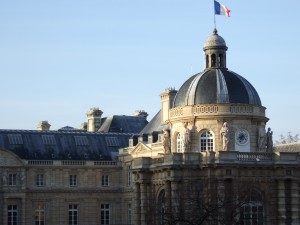
The view from our room at the Hotel Michelet Odeon, our usual home away from home in Paris.
4 March
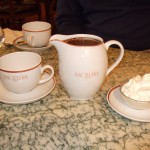
Angelina — phenomenal hot chocolate on the Rue Rivoli, near the Louvre.
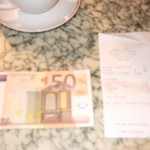
Trying to pay for Angelina with a 50 Euro note, proving (based on the look of chagrin on the waiter’s face) that even busy places in France bound to have change don’t like to make change.
The 1st Sunday of the month means most of the major museums in Paris are free. We stopped first for a coffee at a small shop in front of the Odeon Metro station, “Snack Time,” where a smart aleck drinking a tall Heineken at 9:45 decided to make a snide remark about our little Ziploc baggie of Euro coins. We imagine this nitwit thought we’re some idiotic Americans who can’t figure out foreign money. Annabella almost said to him (in French), “Since French is one of the 4 languages I speak I’ll have you know that I hoarded all the coins so that I wouldn’t get heavy sighs and rolled eyes from all the delightful French waiters and shopkeepers when trying to pay for anything without exact change or with anything larger than a 1 Euro coin.” She could have gone on and on, in French, about how ATMs in France dispense 20 and 50 Euro notes but don’t actually have tellers or anyone who can make change for you, leaving it a gigantic mystery as to how you’re ever supposed to acquire smaller bills.
We walked away and went to Canton on 6, Rue de Buci (6e) for a good pain chocolat and a small bag of their delicious cougettes (little hollow sweets with crunchy sugar on top, €2.80 for 100g).
Metro to the Louvre goes by the Louvre-Rivoli stop, which has replicas of museum pieces on display. The stop with direct entrance access, though, is Musee Louvre (the next stop). As soon as we saw the mass exodus at the stop we knew that the free Sunday thing was going to be a problem. The line already extended back to the escalators, though it moved quickly and took us about 20 minutes. We headed straight to the Italian paintings for inspiration for my art history paper due a month after we got home and decided to take notes on Giotto.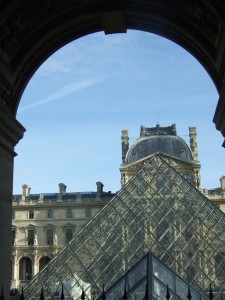
The mob at the Mona Lisa was unbelievable. We continued meandering around the museum and eventually stumbled to the Leon entrance. Note to use this entrance on future visits since there were hardly any people there.
We headed to Rue Rivoli for a hot chocolate break at Angelina (see our Delicious Foods page for more info). Incredibly delicious! Since Angelina is a busy and popular spot, it seems like a great opportunity to break a €50 note. The waiter was nice by French standards, and overworked, and the presentation of the 50 Euro note of course prompted him to ask if we had anything smaller. We lied and said we didn’t, and we finally got that darned note changed.
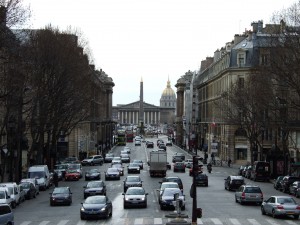
The walk from Place de la Concorde to the Church of the Madeleine will reward you with views, a stop at Laduree, and the beauty of the church itself.
We walked up to the Church of the Madeleine with its wonderful views down to the Place de la Concorde. Mass was just ending, so we enjoyed some organ music.
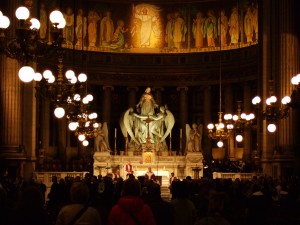
Try to make it for mass so you can enjoy the organ while you observe the beauty of the church.
Stopped for macarons at Laduree on Rue Royale (see our Delicious Foods page for more info). My wife asked the woman standing next to her in line for a flavor suggestion, and she responded, “I really love the pistachio, but the caramel is good, and the chocolate, and so is the vanilla, and ….” If there was a Renaissance painting of us eating the macarons it would have been titled, “Ecstasy at Laduree.”
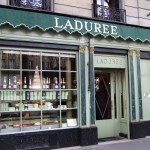
L’Orangerie doesn’t open until 12:30 on Sundays, and by the time we arrived around 1:00 the line was out of control, so we skipped it and went to Montparnasse to visit the Musee Jean Moulin, a WWII and Resistance museum. There are some explanations in English, and lots of information about LeClerc and the liberation of Paris. Upstairs a film is shows on many screens in a semicircle but is entirely French audio with just a few English captions. Just as well as it is a bit annoying to hear LeClerc yammer on saying, “Paris has liberated itself. French troops have liberated us.”
We grabbed a snack at Asie Delices, a Chinese takeout across from Montparnasse Station and walked over to Montparnasse Cemetery.
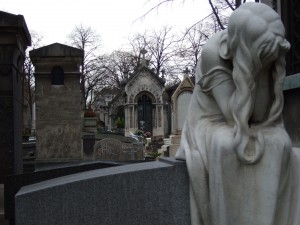
Montparnasse Cemetery
The cemetery is the final resting place of many famous French like Fantin-Latour, Citroen, Vercors (author of Annabella’s favorite French book, “La Silence de a Mer,” which she has always thought would make a brilliant black & white film), Serge Gainsbourg, and many others. It was Gainsbourg’s birthday or anniversary of his death or something because he grave was crowded and piled with fresh flowers. It is a typical French cemetery with elaborate mausoleums and gravestones. One curiosity is how many orders of nuns have crypts there with just a few sisters buried decades and then no more. Of course the priests have very fancy mausoleums. A great book for fans of cemeteries is Permanent Parisians. We also have the book Permanent Londoners.
Sunday is also the Sunday Art Market in Montparnasse, which was had just read about in our in-flight magazine. There was some good art, and some bad/ugly art. . We picked up a couple of cards with drawings on silk of 1920s style ladies and also an etching of an Art Nouveau Metro sign that is now framed and in our dining room. The artist told us he was surprised to see Americans buying an etchings, which are popular with Italians and English but not with Americans (who prefer lithographs) or with French people either.
The line a L’Orangerie had subsided by the time we returned. It was the final day of a Realism exhibit that was too crowded to really enjoy, but the renovated building itself is something to enjoy. Though we’re not really big fans of Money, the space created for his Nymphis is excellent, as is the permanent collection there (which includes lots of Rousseau, Picasso, Matisse, Renoir, and Paul Guillaume).
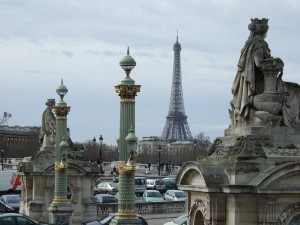
Dinner was at Leon de Bruxelles, which I don’t really care for but which had a non-smoking section and specializes in one my wife’s favorites, moules en frites (mussels with French fries). Dessert was our last crepe for the trip at the stand outside Odeon Metro, and then back to sleep for our trip home the next day.
Photo Gallery

Butcher shop outside Grenoble.
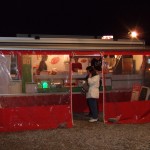
The suburban Grenoble Pizza Van.
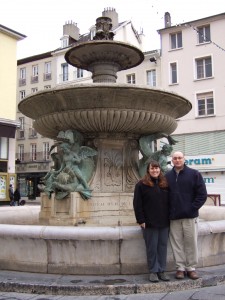
Grenoble
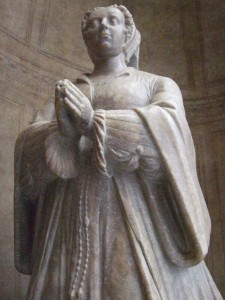
Cathedral of St. John the Baptist, Torino (home of the Shroud)
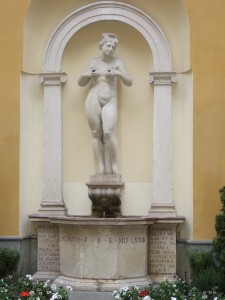
Another statue I liked in Torino.
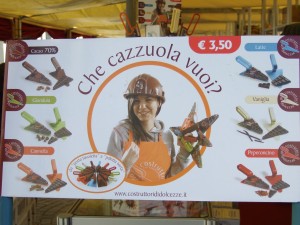
Translation impossible, but really funny. Check out her hands. The cazzuola is made, of course, of chocolate.
